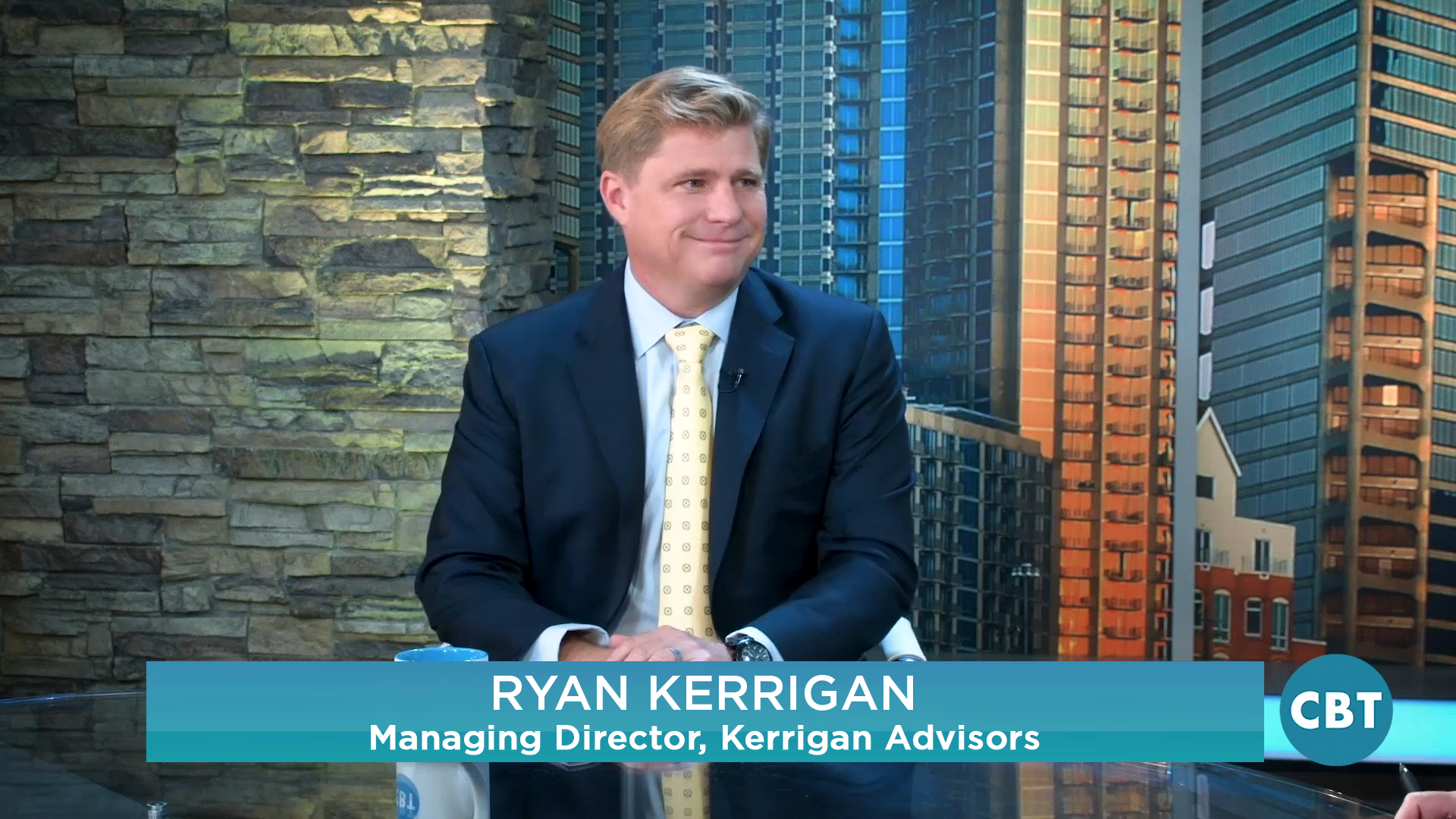On today’s show, we’re pleased to welcome back Ryan Kerrigan, managing director of Kerrigan Advisors. In this segment, Ryan and Jim discuss the state of auto retail’s buy-sell market, consolidation trends, what the public stock prices are doing, and the key takeaways from the Blue Sky Report.
VIDEO TRANSCRIPT:
Jim Fitzpatrick: Hello, everyone. I’m Jim Fitzpatrick. Thanks so much for joining me on another edition of CBT News. Today, I am so excited to have in the studio with us Mr. Ryan Kerrigan, who’s managing partner, managing director of Kerrigan Advisors. Thanks so much for coming by the studio.
Ryan Kerrigan: Jim, good to be here.
Jim Fitzpatrick: Yeah, we usually do this in a Skype video or something, so it’s good to have you here in Atlanta.
Ryan Kerrigan: Good to be in Atlanta.
Jim Fitzpatrick: Yeah. So let’s kind of dive right in here. How has the buy-sell market fared in the first half of 2019?
Ryan Kerrigan: Well, the hit parade continues, 103 total transactions in the first half of 2019.
Jim Fitzpatrick: Wow.
Ryan Kerrigan: So we are on for a sixth year of a tracking to over 200 transactions, so we’re continuing to see lots and lots of activity.
Jim Fitzpatrick: That’s fantastic. And so sellers continue to come to the market?
Ryan Kerrigan: Yeah, they do. And part of it is just that ongoing generational shift that we keep talking about and I’ve been talking about for years, and that is that these assets have been in families for a long, long time. So that continues. The other big driver are simply people are recognizing the model is changing, and they are deciding whether they want to go along with that change or sell. And it’s a good option. Either you can sort of really bone up and understand where the industry’s going and what technology, and you start adapting in your business.
Or there’s great value in these franchises, sell them. So I think there’s a fork in the road that a lot of dealers are facing, and some are opting to take really good valuations and go to market and put that money in the bank.
Jim Fitzpatrick: How are the Blue Sky valuations holding up? Did you leave a bunch of money on the table if you didn’t sell in 2015 rather?
Ryan Kerrigan: Well, Blue Sky multiples in general are quite strong. There are examples where 2015 was a peak in a lot of ways. We peaked in SAAR, we peaked in average profitability, and clearly, with the benefit of hindsight, looking back, there are some dealers that could have gotten significantly more money in 2015. That said, good franchises, good markets, still selling for really, really strong value.
So I’d say the more dependent that you were on new car profits and new car volume to generate your profits in 2015, those kinds of dealers are probably looking at reduced profitability today and reduced value. But for those that were emphasizing used car, FNI, fixed operations, profits are really strong, numbers are really strong, so it depends on where you sit.
Jim Fitzpatrick: Okay. Since 2014, you estimate 12% of the dealer body has sold, about 1,190 dealerships. Looking ahead to 2024, does that continue?
Ryan Kerrigan: Yeah, I mean that’s a pretty incredible stat. 12% of dealers have changed hands in the last five years. Yeah, that trend absolutely does continue in our mind. The things we talked about, the change in technology, the question as to whether or not you’re going to do what it takes to innovate, to be involved in the next sort of leg of the game continues. And so we’re going to continue to see people opt out. And again, it’s not a bad choice. Values are strong today. and so do I take some risks? Do I try to figure out what the next 20 years looks like?
Jim Fitzpatrick: Sure.
Ryan Kerrigan: Or do I simply take this very nice option to exit now?
Jim Fitzpatrick: So overall, consolidation continues.
Ryan Kerrigan: Well, it absolutely does continue. That’s the general trend. But I want to say, with all of these transactions, it’s not a one-way street. There are a lot of big groups that continue to sell dealerships to individuals or groups or partnerships that are buying their first store or second store or third store. So the overall industry, we’re seeing very slow, steady consolidation. But there again, there are still lots of new faces getting into the game.
Jim Fitzpatrick: Yeah. That is to say the new operators are still getting into the game then?
Ryan Kerrigan: They are, absolutely. Yeah, new young operators sometimes partnering with outside capital are absolutely coming into the game. So it’s not an industry where sort of the incumbents are taking over, and it’s just going to be a story simply of larger and larger, deeper established guys owning the industry. They’ll continue to do what they’re doing, but there’s still lots of opportunity for new players to get in.
Jim Fitzpatrick: Okay. And when you say private capital, is that the same as private equity?
Ryan Kerrigan: No, it’s not. It’s a really good question. I’m glad you asked it. So private equity, and this is important for dealers to understand, private equity, they are the most common types of firms out there. They’re also the most active in reaching out. They’re actually the least likely to actually step up and do a deal.
Jim Fitzpatrick: Are they really? Okay.
Ryan Kerrigan: Absolutely.
Jim Fitzpatrick: Interesting.
Ryan Kerrigan: The issue with private equity as conventionally defined is that they’re control investors. That’s a challenge because the OEMs are not comfortable with the private equity having control. And they’re thinking in three-to-five-year windows, and that also doesn’t work for the OEMs.
Jim Fitzpatrick: Right, right.
Ryan Kerrigan: So the structure doesn’t work well, but there are other types of private capital that work much better. So at the end of the day, while there’s a lot of talk of private equity, I think as an industry we should kind of put private equity on the shelf and talk about private capital. And there are great sources of private capital that are going to get into our industry and help operators consolidate.
Jim Fitzpatrick: You talk about how dealerships with poor online reputations experience multiple compression. Can you explain that?
Ryan Kerrigan: Yeah, absolutely. You know, prior to this, we never saw, for example, buyers being all that concerned about what was going on inside the store. Their view was “I can go in there, I’ll keep what I like, I’ll fix what I don’t. If I need to change people, change culture, change accountability, I can do that.”
Jim Fitzpatrick: Right.
Ryan Kerrigan: Now, it’s interesting. With social media reputations, that’s sticky. That’s something that doesn’t change. So I can go in, and I can fix all the things inside the dealership that I need to fix.
Jim Fitzpatrick: Right.
Ryan Kerrigan: But I’m stuck with whatever that impression is of that dealership.
Jim Fitzpatrick: That’s true.
Ryan Kerrigan: So that’s something that buyers are paying more attention to. And we’re finding that, in a severe situation where there’s just a really, really poor reputation, buyers will discount that.
Jim Fitzpatrick: Yeah, for sure. A name change is going to be essential in a situation like that, right?
Ryan Kerrigan: Yeah, yeah.
Jim Fitzpatrick: To let them know it’s a whole new deal.
Ryan Kerrigan: That’s right.
Jim Fitzpatrick: How do interest rate cuts affect the buy-sell market?
Ryan Kerrigan: Well, we remain in a low-interest-rate environment, and now we’re even seeing rates coming down a little bit, and that’s a great thing. It helps the car business and car sales. It brings down the cost of financing dealerships. Just in general, low-interest rates are great for our industry.
Jim Fitzpatrick: Right, right. SAAR hasn’t been growing. The headlines can continue to be pretty dismal, but how are the dealerships across the country performing?
Ryan Kerrigan: You know, dealerships are doing just fine. We’re actually seeing … so we came off that 2015 high. Average profits dipped down the last four years ever so slightly, but we’re actually seeing that trend reversed. In 2018, we at Kerrigan Advisors thought that the emphasis on the higher-margin parts of the business and letting that sort of new car margins come to the new normal would allow dealers to focus on the higher-margin stuff and turn that around. And on average, they have.
And then you look at the really strong performers, profits are growing considerably each and every year because they’re focused on used cars, fixed operations, the high margin parts of the business.
Jim Fitzpatrick: Right. David Holt recently said, “We modeled this thing out all the way down to 8 million SAAR, and we are confident in the model that we can continue to grow the business.” Can private dealers say the same thing?
Ryan Kerrigan: Yeah. In general, they can. Again, we’ve got a very variable fixed or non-fixed expense structure. So, in general, the key is to manage your debt levels.
And so, if your debt levels are not on a line, you can absolutely bring down the cost pretty quickly in the model. So 8 million is pretty extreme. I thought it was interesting that he went to, for example, that extreme. But nevertheless, if we do find ourselves in a situation where SAAR is down considerably …
Jim Fitzpatrick: Right.
Ryan Kerrigan: No question. Dealers can adapt, and they’ve done it before.
Jim Fitzpatrick: The public stock price is up considerably year to date. What do you attribute this to?
Ryan Kerrigan: It’s been a great year for the public, so we’re up through mid-September, like 36% year to date, and that’s more than 20% over what the market’s done. So it’s been a great year for the publics.
Publics got beat up pretty badly in 2018. There was a lot of scare. You know, what does this mean? Are we going into recession? How resilient are these models? And in 2019, I think the public markets have come back and reassessed these publics and said, “You know what? These are very resilient models.” There again, it’s not just the store, but the new cars. It’s what’s going on in these dealerships, which are five different business models. And so I think the markets have recognized what we all know in this industry and that this is a very diversified business model. And just because new car goes down or just because some of the macroeconomic headlines are not that strong, it doesn’t mean the dealerships stop making money. And so the markets have recognized that.
Jim Fitzpatrick: Yeah. you suggest the multiple of a store needs to be lower than the multiple of the public acquired or acquiree stock. My understanding is that most of these are done in cash. Why is the multiple the driver? Talk to us about that.
Ryan Kerrigan: Yeah, no, that’s a great question. There’s no question that, at the point of doing a sale, that cash is being transacted, rarely a stock involved. But the way that a public company would manage a given transaction and how they manage their overall balance sheet are distinct. And so, if you do lift up, however, at the end of the day, the publics are going to be constrained by what their stock price is.
So embedded in their stock price, there is an implicit Blue Sky value. Now, we don’t know exactly what that is because we don’t have access. No one has access to all the data, at least those of us that are outside the company. But we can sort of impute or guess what the Blue Sky value is. And managements of public companies, they have to do creative acquisitions. They have to use that balance sheet as best they possibly can to make more earnings per share, and they can only do that if they’re paying less than the stock price.
Ryan Kerrigan: Now, there are other scenarios I should note. If they’re buying situations where they feel that they can turn something around or there’s cost synergies, then that can help them get there. But at the end of the day, the acquisitions need to be done at a level that they’re accretive to earnings. So that’s why that stock price matters so much.
Jim Fitzpatrick: Okay. And since 2018, the publics have divested 70 franchises in the same time that they’ve acquired 31. What’s going on there?
Ryan Kerrigan: Yeah, it’s a good question. The publics are not in growth mode, at least as it relates to buying new car franchises. Of course, they’re pushing on FNI, they’re doing used cars, but on the new car franchises, they are pruning. They are getting out of many of the volume brands that they think, for example, would be susceptible in a downturn. They’re always negotiating with the OEMs how they can position for increasingly better points, but sometimes they need to let things go in order to get OEM approval. So there again, we mentioned earlier the publics only account for 5% of the current marketplace when it comes to buy-sell.
So they are just not significant. That said, with that strong stock price, that could increase in the coming months. We do anticipate there’ll be some announcements in the coming quarters reflecting the stronger stock price.
Jim Fitzpatrick: Okay. Talk to us about the Blue Sky. In the Blue Sky report, you site nine consecutive years of FNI PVR growth. Do you see the end in sight on that?
Ryan Kerrigan: No. And the reason that we point that out is that the public companies tend to be much more compliance-oriented for obvious reasons than your typical private dealer.
Jim Fitzpatrick: Yeah. The model is …
Ryan Kerrigan: So the fact that the publics have been able to emphasize this and push up FNI per vehicle so consistently year after year after year, taking it from a thousand up to over 15 almost 1600 a copy.
It shows what we can do in this industry because, if the public can do it with the constraints that they have on their businesses and the scrutiny they have on their businesses, then in the private world, we can do that all day long.
Jim Fitzpatrick: Yeah, there’s no question. Any hot brands at the moment?
Ryan Kerrigan: Yeah, Subaru continues to have a great roll, and we’re really seeing Subaru build out their national network. So this has gone from a more of a niche product to now a very significant import brand.
Jim Fitzpatrick: Their success has just been unbelievable.
Ryan Kerrigan: You’re probably seeing it here in Atlanta as well.
Jim Fitzpatrick: Yeah.
Ryan Kerrigan: So we’re seeing them build up their national network. There’s a lot of demand amongst large dealer groups to add Subaru. We’ve also got positive ratings on Chrysler and on Volkswagen. We’re seeing more demand there.
So our anticipation is we could be increasing the Blue Sky multiple for those franchises and future quarters as well.
Jim Fitzpatrick: Yeah, that’s phenomenal. Good to see Volkswagen coming back strong from their problems that they had a few years back.
Ryan Kerrigan: Yeah, it is.
Jim Fitzpatrick: And so any franchises that people are avoiding? You said Nissan.
Ryan Kerrigan: Well, right now, Nissan.
Jim Fitzpatrick: Right now, Nissan.
Ryan Kerrigan: Unfortunately, you have to …
Jim Fitzpatrick: They’re like the poster child of these dealers, I mean these OEMs that want to get kicked.
Ryan Kerrigan: Yeah.
Jim Fitzpatrick: Nissan’s at the top of the heap.
Ryan Kerrigan: In addition to … So no one’s making any news by saying that the relationship between the OEM and the dealership, the dealers rather, in Nissan world has always been challenged, although certainly there are some guys that do very well with Nissan and have had that good relationship.
Jim Fitzpatrick: Right.
Ryan Kerrigan: But across the board, it’s been a challenging relationship. Now you have to factor in just tremendous uncertainty. There’s just so much change going on in that organization from corporate headquarters all the way down.
And so, yeah, we are seeing buyers just very wary in general of the brand. And it’s really about uncertainty. Now, having said that, throughput per stores, if you look at the number of cars they’re selling per dealership, they’re amongst best-in-class in the industry. There are a lot of very high-volume, very high-profit Nissan stores. But clearly just the level of uncertainty does sort of beg the question where are we going here?
Jim Fitzpatrick: Yeah. And that actually surprises me because it’s such a strong brand, and it has been for so long, and Toyota’s had its problems and other high-volume OEMs have had their problems. So is now a good time to buy a Nissan franchise? Would you put your money on a franchise?
Ryan Kerrigan: Well, I like how you think. I think investors are often contrarian, and so I like the question. Yeah, I think this is a large global company. It is not going away. And frankly, there is so much negative perception around the company today that you could look at it, I think, and say, “You know what the odds are. There’s always risk in everything you do. But the odds are that going forward there’s going to be a lot of positive news coming out of the organization relative to where we are today.”
And so, as I mentioned, really high-volume stores. Some of them are very profitable. They can be bought for very reasonable multiples. I think, for someone looking at a brand portfolio, it’s a very reasonable investment.
Jim Fitzpatrick: Yeah. And so looking ahead, what does the buy-sell market look like for 2020?
Ryan Kerrigan: We just don’t see it changing. I think the nature and the tenor of it will go with the macroeconomy, and that is to say that, to the degree, the economy continues, then you’re going to see status quo. If it tails off, you’ll see valuations and profitability down. But in terms of the pace of what’s going on, we just don’t see that changing.
Jim Fitzpatrick: Okay. And then talk to us about elections. What role will that play in the valuations and the buy-sell market for 2020?
Ryan Kerrigan: Yeah, I think we’ve tuned out elections. I don’t see the elections affecting us really at all. What I do see affecting us is policy.
Jim Fitzpatrick: Yeah, okay.
Ryan Kerrigan: Now, if there are policy changes that come as a result of elections, that could have very significant implications. But as it relates to politics and what we’re reading about in the news and the elections coming up in 2020, we just don’t see that as being a big player.
Jim Fitzpatrick: Well, Ryan Kerrigan, managing director of Kerrigan Advisors, I want to thank you so much for joining us on CBT News. This has been very informative. I know dealers and our viewers are going to get a lot out of it, so thanks so much.
Ryan Kerrigan: Great. Thank you, Jim.
Jim Fitzpatrick: Yeah.
Ryan Kerrigan: Good to be here.
CBT Automotive Network, the number one most-watched network in retail automotive. This has been a JBF Business Media production.









